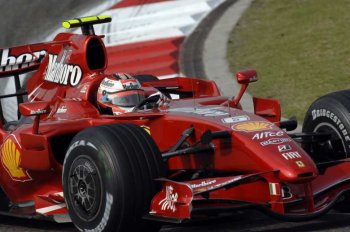|
The Brazilian
Grand Prix marks not only the end of the 2007 Formula 1
season, but also the end of the first year in the sport's
history in which engine development has been frozen, as part
of a cost cutting measure.
Both Kimi Raikkonen, still in with a slim chance of taking
the Drivers' title and Felipe Massa, keen to win at home for
a second consecutive year, will start the seventeenth round
of the world championship with a new engine in their F2007.
However, unlike past years, the freeze on engine work means
the Brazil engines will be fundamentally the same as those
used in past races. "This year has been quite different on
the engine side, different in terms of development, as
although there are still some areas where engine development
is possible, it is on a much reduced scale compared to the
past," says Mattia Binotto, Ferrari's Head of Track
Engineering - Engines.
"The work we can
do is very limited. However, this difference applies only to
design and development of the engines, because in terms of
our trackside operations, I have not noticed any changes.
The management of the engine over a race weekend remains the
same, which means you are operating with some targets and
limits trying to get maximum performance out of the engine
while managing its reliability. Those elements remain the
same as ever."
Restrictions on evolution and development of the engines
have also had an effect back in the factory. "Our planning
of how the engine workshop operates in terms of production
of components and assembly has changed considerably,"
continues Binotto. "In the case of most of the components of
the engine you are able to anticipate production and
increase the efficiency of all our activity and that is
quite a big benefit in terms of cost reduction because you
can set out a regular plan for this."
For the first time since 2001, when Ferrari supplied the
Sauber and Prost teams, once again this year the Maranello
marque has supplied two customer teams - Scuderia Toro Rosso
and Spyker - with engines. "The freezing of engine
development has helped a lot in allowing us to provide this
service, because again you are able to schedule and manage
the full activity quite some time in advance," explains
Binotto. "We have done a great job this year and part of
that is down to the engine freeze. On the other side I would
say that our collaboration with both Toro Rosso and Spyker
has worked very well.
|

 |
|
Both Kimi Raikkonen (above,
at Shanghai), still in with a slim chance of
taking the Drivers' title and Felipe Massa, keen to
win at home for a second consecutive year, will
start the seventeenth round of the world
championship with a new engine in their F2007. |
|
|

 |
|
The Brazilian Grand Prix marks not only the end of
the 2007 Formula 1 season, but also the end of the
first year in the sport's history in which engine
development has been frozen, as part of a cost
cutting measure. Photos: Kimi Raikkonen in Shanghai. |
|
|
"Also in terms
of performance we made a significant step forward through
the season, as can be seen especially by Toro Rosso's
performance in the last couple of races. At the start of the
season, life was quite difficult on the customer front
because we had a very short time to prepare and work out the
installation of the engine in the chassis. But with both
these teams, we caught up and made some good steps forward.
Now we are looking to move forward again with both teams
next year. We have enjoyed a good relationship and a good
collaboration. Our engine guys in Maranello are very happy
to have had four Ferrari engines in the top six at the last
race in Japan. Ferrari is supplying these two other teams
mainly for technical reasons, as it is a benefit to be able
to run each race with six engines. The amount of feedback is
important in terms of reliability and engine usage."
For Brazil, the two F2007 are fitted with fresh engines. "In
the past, when we had this situation of not having to
prepare an engine to last for two races, it could lead to
some extreme engine experimentation from teams, but now with
the engine freeze there are limits to what can be done,"
says Binotto. "In the past you could have carried out
dedicated development for just a single race or even built
special components with a shorter life. Now, all components
must remain the same but it is true that the distance the
engines that we bring to Sao Paulo must cover is divided by
two: five hundred kilometres instead of one thousand. It
means that we can try to increase the severity of usage of
the engine, for example by running higher revs, try to get
the maximum benefit in terms of performance. We can also run
it at higher temperatures. As for the Interlagos circuit
itself, the main feature as far as the engines are concerned
is its height above sea level which causes a reduction in
power. On top of that, the fact the main straight past the
pits is uphill also means that engine power is at a premium.
You therefore need to aim for maximum power down the main
straight to give you the opportunity to overtake, so the
choice of gear ratios is very important. These factors mean
that, when setting up the car, it should be optimised not
necessarily to get the best lap time but more for maximum
speed and acceleration on the main straight."
|
|
|
|